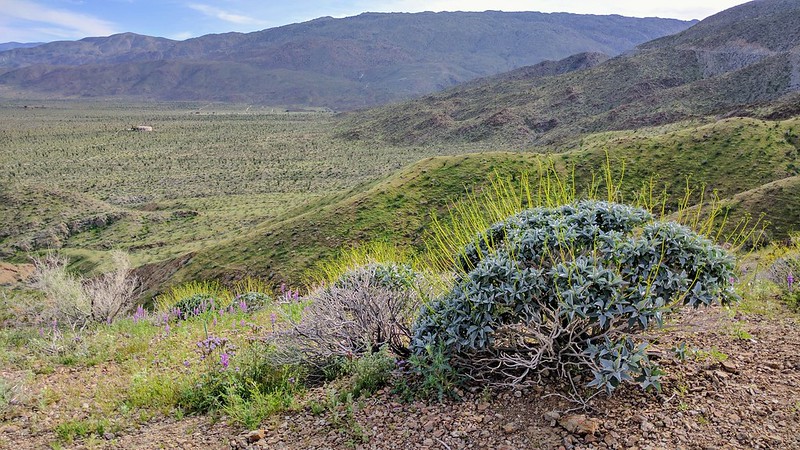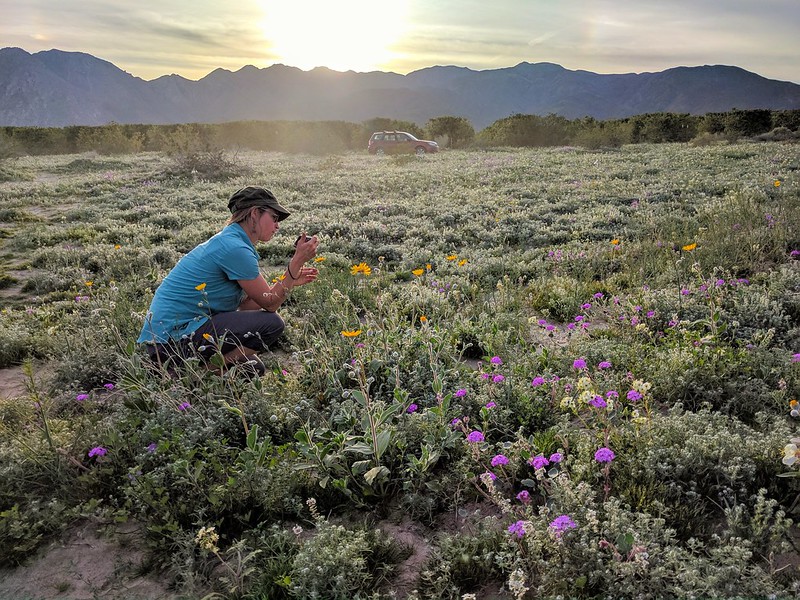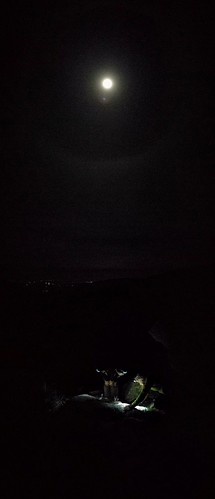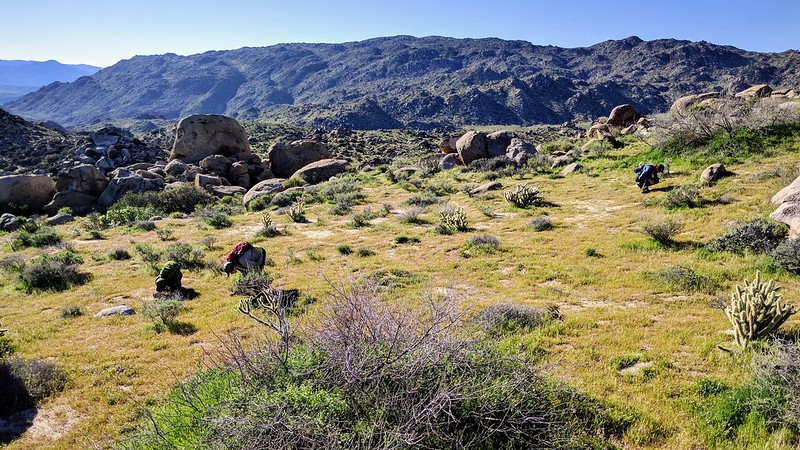Borrego Botanizing March 2017

With reports of a "superbloom" in the offing, I felt a desert trip was in order, so some botanically-inclined friends and I headed down to Anza Borrego, where we met up with some SoCal iNat folks and saw a lot of plants. It was great. Huge thanks to @finatic and @matthew_salkiewicz for sharing their time and knowledge on Saturday, and to Stew Winchester and Fred Melgert for providing some remote location tips.
I mostly just want to use this post to help me remember some of the logistical details for future explorations, so apologies for the brevity. For the curious, observations by everyone in our group and those iNat-folks we met are at
As I write this, it seems like together we've received help from 100+ identifiers! That makes me feel great. Many thanks to all of you!
Thursday 3/9
Sylvie, Angela, and I drove down 101 in the evening and camped at Oak Flat Campground, a Forest Service campground right off I-5 near Castaic. Lots of beer bottles and broken glass, but otherwise a fine place to stop between the Bay Area and the deserts.
Friday 3/10


After waltzing through some poison oak we continued on our merry way and arrived at Culp Valley campground around 2pm... which was almost full. We claimed a spot, but it was kind of nuts. Still, lots of good stuff around the campsite, which is quite a bit higher than the valley floor and has a different flora. Saw my first Lithariapteryx, a colorful genus of moths that has some dune endemic species with wonderful illustrations in Powell & Opler. Meanwhile, Damon and Cynthia started their drive and checked out the Lancaster area, which apparently wasn't blooming, but Damon still managed to see this totally sweet wingless crane fly and discovered that some ants have beards. Back in Anza, S, A, and I decided to head down to the valley and glean what info we could from the visitor's center. On the way down we couldn't resist making some stops at the pullouts and were rewarded with all kinds of amazing things, including our first Nemacladus. Appetites: whetted. Borrego Springs was not completely insane at that point, but it was still pretty busy. We got a map of recommended spots and decided to try Di Giorgio road to find some desert lilies (later we realized the map was actually a pretty good guide to avoiding the crowds: just go anywhere not on the map). Di Giorgio passes through some dense orange groves, which were in flower and unleashing a heady miasma of scent, making it impossible to really smell any other flower. Nevertheless, there were lilies everywhere at the end of the road, along with fields of spectacle pod, Abronia, brown eyes, etc. The dusk lighting, heady aroma, dust from the cars, and many other fellow flower aficionados (including a group of Buddhist monks) made for a surreal but pleasant evening. For extra surreality, in SoCal while you are botanizing a well-journalized bloom, apparently other people are doing this.
That night Cynthia and Damon rolled in, as well as Sean and Cat, who flew down (like, in a plane). Set up the moth light though it didn't bring in too much. Had more entomological success wandering around with headlamps. Timema galore adorned the buckwheats and other shrubs, butts held high into the night. Why? Waiting for mates? Can't the bats "see" them or do they just look like sticks if you're echolocating? Found some caterpillars too. Had been consulting Dave Wagner's caterpillar book a week or two before and he mentioned they were easier to find at night. Now I believe.
Camp was a bit noisy due to the crowding and some particularly noisy neighbors. Was glad of my earplugs.
Saturday 3/11

Connected with BJ and Matt in the morning despite my stealthy sombrero-based disguise. Decided we would try to relocate desert lupine and Ives' phacelia at Dump Rd east of Borrego Springs, two flowers that came up in this bloom but hadn't been seen locally in decades. There seem to be checklist records of both on Calflora from 1997, but it's not clear to me if those represent actual observations or just someone making a list of what should be there. If those 1997 records are not observations, then L. shockleyi hasn't been seen around Borrego Springs since 1939, and P. ivesiana hasn't been seen since 1895 (!!), when it was collected by T.S. Brandegee, husband of M.K. Brandegee, former curator of botany at the California Academy of Sciences and one of the pioneering female scientists the Academy prides itself upon. T.S. apparently was no botanical slacker either. I suspect the seeds that germinated this year weren't actually waiting around for 100 years and people just hadn't noticed it in the intervening century (it's pretty small), but regardless 122 years is a long, long time for a plant to go unnoticed, and I'm sure the seeds were lying dormant for decades at least. Remarkable.
From there we headed to into Borrego Springs to use the facilities and fill up on water. There we witnessed the horde of people who also had come to witness the "superbloom," and, apparently, also need to use bathrooms and drink water. The gall. Usual conflicted feelings of excitement over interest in nature and horror over loving nature to death, etc.
Next up, Glorietta Canyon, which, while not empty, was relatively uncrowded by people and very crowded with flowers. Road in was totally accessible, even saw a Prius successfully navigate it, though apparently that's not always the case. Seemed like there was also camping near the entrance, though no water or bathrooms. Met up with @biohexx1 and a woman whose name I didn't catch there too! Flora was a lot like our roadside stops down S22, but we saw a lot more stuff with time to move slowly and the input from the local experts.

Finally, we decided to do a quick walk and run BJ's moth light for a while at Yaqui Wells, where mushrooms managed to find Damon as they tend to do, and we saw the lyrepod open up for the evening. The light didn't bring in too much, but still, fun times. Failed to extract some folks who got their sedan stuck in the sand up to the axle, and also failed to connect with our friend Nik, who was nearby.
Parted ways with BJ and Matt, onto Borrego Springs where we refilled the water tank at a coin-operated water machine outside a liquor store, then back to camp. A little more nocturnal exploring around camp revealed a different suite of things, including fungally-infected flies, sleeping marbles, and more caterpillars. Neighbors far less noisy that night, plus I was way more tired.
Sunday 3/12
Parted with Cat, Sean, and Cynthia in the morning (after seeing my first Scott's Oriole around camp), decided we would try our luck due south away from Borrego Springs. First stop was across from a dirt road with a "no camping" sign. I don't even remember why we pulled over, maybe to look at the beautiful teddy bear cholla. Turned out to be enormously productive and we added several species we saw nowhere else on the trip, including two more Nemacladus and desert five spot. Cholla was brutal, though, damn near impossible to avoid and hard to extract.

Next we tried Torote Canyon in search of frankincense (er, elephant tree) and whatever else we could find. Road in was slightly more dicey than Glorietta, but it seemed like people with less clearance than us were managing ok. Taking a tip from Sean, Cynthia, and Cat the day before, some of us took naps in the shade.
Since we hadn't had enough, we decided to try Moonlight Canyon, despite mild exhaustion (at least on my part), and were in no way disappointed. Found the glorious Lytta magister at Agua Caliente, as well as just a very different sort of desert habitat in Moonlight, where there was a trickle of water, weird milkweeds, different asters, and after nightfall, Red-spotted Toads, bats, poorwills that sadly went unphotographed, and hooting owls.
Back at Culp Valley things had quieted down significantly. Still a few folks around, but mostly empty. For some reason decided to walk around a bit and again found different things, including a weird grasshopper, a new walking stick, and two flowers we had somehow missed, including a jewelflower.
Monday 3/13

Explored camp a little more and then hit the road. Nice poppies along CA-79, but insane floral displays along I-15. Stopped at Minthorn St. in Lake Elsinore for some amazing fields of Phacelia minor, and at Walker Canyon for what were probably the most insane poppy displays of my life to date. Walker was crowded, but not to the detriment of the flowers. There was a drone crew there and I can't find their footage, but it seems like numerous other people were flying drones and shooting video. Here's one:
Half pleased, half creeped to know I was probably being filmed by several people with phones and several robots in the sky.
Final botanical moment was some spectacular washes of Monolopia along CA-46, some of which were accessible from the road. Lovely mix of Monolopia, Amsinckia, and Phacelia. Also huge fields of what looked like pure Amsinckia. Made me want to plant it at home in the hopes that it would outcompete the introduced weeds in the yard.
All in all, a fantastic trip. The desert is truly amazing. Also, I had what is becoming my usual experience with other iNat folks: you people are amazing at noticing and photographing stuff! Not to mention knowing and sharing stuff. I was again enormously grateful to hang out with such wonderful naturalists.






